📚 Atomic Habits by James Clear

🎯 Read This Book If
You want to feel in control of what you do each day while working towards what matters most to you.
🔑 Key Points
- Atomic habits: a regular practice or routine that is not only small and easy to do, but also the source of incredible power; a component of the system of compound growth.
- To create a good habit we can implement the Four Laws of Behaviour Change: make it obvious, make it attractive, make it easy, and make it satisfying.
- To break a bad habit we can invert the Four Laws of Behaviour Change: make it invisible, make it unattractive, make it difficult, and make it unsatisfying.
🤔 Main Ideas
A habit is a routine or behaviour that is performed regularly, and in many cases, automatically.
Changes that seem small and unimportant will compound into remarkable results if you stick with them. We all deal with setbacks, but in the long run the quality of our lives often depends on the quality of our habits. With the same habits, you'll end up with the same results. With better habits, anything is possible.
Human behaviour is always changing. But the fundamentals of human behaviour never changes.
The Fundamentals
We convince ourselves that massive success requires massive action. If you get 1% better each day for one year, you get 37 times better by year end. Habits are the compound interest of self-improvement.
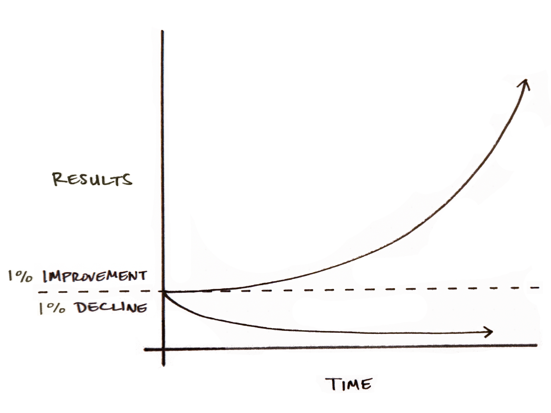
The slow pace of transformation makes it easy to let a bad habit slide. If a pilot leaving LAX adjusts the heading 3.5° south, they’ll land in Washington, D.C., instead of New York. A change that's barely noticeable at takeoff, ends up hundreds of miles apart.
Similarly, a change in your daily habits can guide your life to a very different direction. Success is the product of daily habits, not once-in-a-lifetime transformations. Be more concerned with your current trajectory than with your current results. Your outcomes are a lagging measure of your habits, you get what you repeat. Good habits make time your ally, bad habits make time your enemy.
Breakthrough moments are often the result of many previous actions, which build up the potential required to unleash a major change. The problem is that people make a few small changes, fail to see results, and decide to stop. In order to make a meaningful difference, habits need to persist long enough to break through the Plateau of Latent Potential.
Complaining about not achieving success despite working hard is like complaining about an ice cube not melting when you heat it from -5°C to -1°C. Your work wasn't wasted, it was stored. All the action happens at 0°C. All big things come from small beginnings. The seed of every habit is a single, tiny decision.
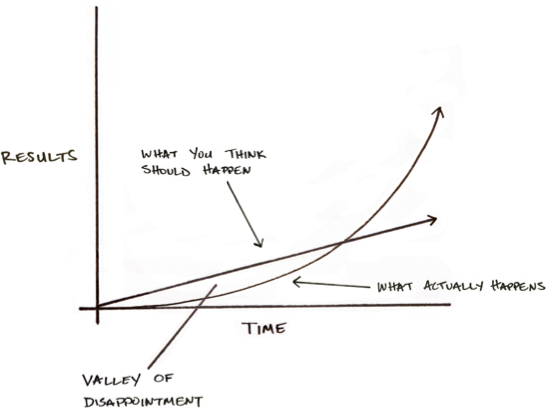
Results have very little to do with goals and everything to do with systems. Goals are about the results you want to achieve. Systems are about the processes that lead to those results. Problems arise when you spend too much time thinking about your goals and not enough time designing your systems:
- Winners and losers have the same goals.
- Achieving a goal is only a momentary change.
- Goals restrict your happiness.
- Goals are at odds with long-term progress.
You don't rise to the level of your goals, you fall to the level of your systems. Habits are like the atoms of our lives. Each one is a fundamental unit that contributes to your overall improvement. This is the meaning of atomic habits – a regular practice or routine that is not only small and easy to do, but also the source of incredible power; a component of the system of compound growth.
Changing our habits is challenging for two reasons: 1) we try to change the wrong thing, and 2) we try to change our habits in the wrong way.
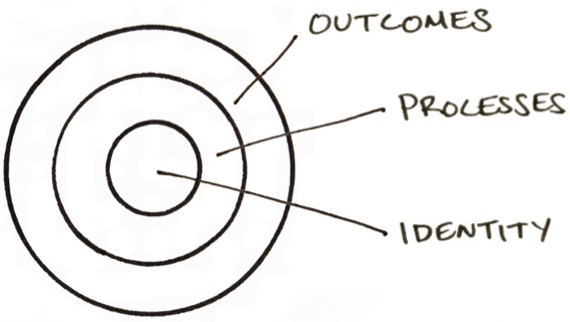
The first layer is changing your outcomes, where most of the goals you set are. The second layer is changing your process, where most of the habits you build are. The third and deepest layer is changing your identity, where most of the beliefs, assumptions, and biases you hold are.
Outcomes are what you get. Processes are what you do. Identity is what you believe. We begin the process of changing our habits by focusing on what we want to achieve. This leads to outcome-based habits. The alternative is to build identity-based habits. With this approach, we start by focusing on who we wish to become.
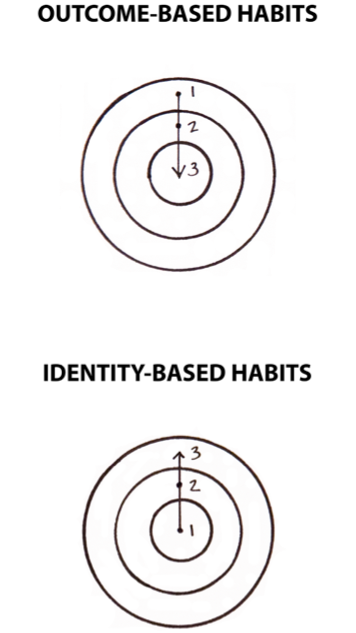
Our old identity can sabotage new plans for change. It's hard to change your habits if you never change the underlying beliefs that led to your behaviour. The ultimate form of intrinsic motivation is when a habit becomes part of your identity. It's one thing to say I'm the type of person who wants this. It's something very different to say I'm the type of person who is this.
Once your pride gets involved, you'll fight to maintain your habits. True behaviour change is identity change. Once a person believes in a particular aspect of their identity, they're more likely to act in alignment with that belief. When your behaviour and your identity are fully aligned, you're no longer pursuing behaviour change. You're acting like the type of person you already believe you are.
When you have repeated a story to yourself for years, it's easy to slide into these mental grooves and accept them as a fact. The more deeply a thought or action is tied to your identity, the more difficult it is to change. Progress requires unlearning, it requires you to continuously edit your beliefs, to upgrade and expand your identity.
Your identity emerges out of your habits, they embody your identity. The more evidence you have for a belief, the more strongly you will believe it. Evidence accumulates and your self-image begins to change. Every action you take is a vote for the type of person you wish to become. As the votes build up, so does the evidence of your new identity. It's a simple two-step process:
- Decide the type of person you want to be.
- Prove it to yourself with small wins.
Ask yourself, "who is the type of person that could get the outcome that I want?" The focus should always be on becoming that type of person, not getting a particular outcome. Your goal is simply to win the majority of the time.
Know who you want to become. Your habits matter because they help you become that person. They're the channel through which you develop your deepest beliefs. You become your habits. Behaviours followed by satisfying consequences tend to be repeated and those that produce unpleasant consequences are less likely to be repeated.
The feedback loop behind all human behaviour is: try, fail, learn, try differently. Whenever you face a problem repeatedly, your brain begins to automate the process of solving it. Your brain skips the process of trial and error and creates a mental rule: if this, then that. Habits are mental shortcuts learned from experience. Habits reduce cognitive load and free up mental capacity, so you can allocate your attention to other tasks.
The process of building a habit can be divided into four simple steps: cue, craving, response, and reward.
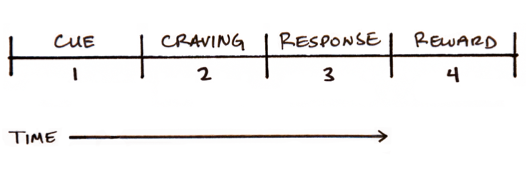
The cue triggers your brain to initiate a behaviour, they're meaningless until they are interpreted. Cravings are the motivational force behind every habit. The response is the habit you perform, typically a thought or an action. Rewards are the end goal of every habit. Rewards serve two purposes: 1) they satisfy us and 2) they teach us. If a behaviour is insufficient in any of the four stages, it will not become a habit.
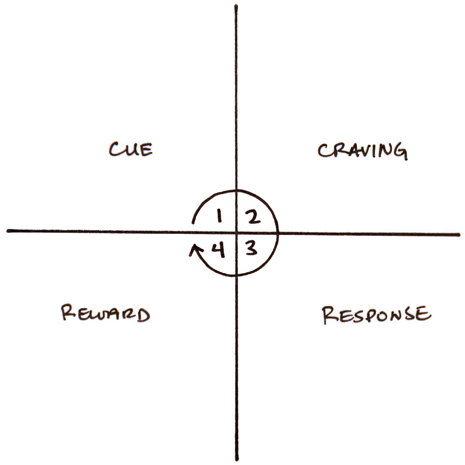
The cue triggers a craving, which motivates a response, which provides a reward, which satisfies the craving and, becomes associated with the cue. We can split these four steps into two phases: the problem phase (cue and craving) and the solution phase (response and reward). The purpose of a habit is to solve a problem.
We can turn these four steps into a practical framework, the Four Laws of Behaviour Change. The key to creating good habits and breaking bad ones is to understand these laws and how to use them. Every goal is doomed to fail if it goes against the grain of human nature.
The 1st Law Make It Obvious
When you experience something repeatedly, your brain begins noticing what's important, sorting through the details, highlighting the relevant cues, and cataloging that information for future use.
You're much more than your conscious self. You don't need to be aware of the cue for a habit to begin. This is what makes habits useful. It's also what makes them dangerous. The more you repeat these patterns, the less likely you become to question what you're doing and why you're doing it.
Cues that spark our habits become so common that they're essentially invisible. Responses to these cues are so deeply encoded that it feels like the urge to act comes from nowhere. Begin the process of behaviour change with awareness. Before effectively building new habits, get a handle on our current ones.
"Until you make the unconscious conscious, it will direct your life and you will call it fate." Carl Jung
When we've done something a thousand times, we begin to overlook things. One of our greatest challenges in changing habits is maintaining awareness of what we're actually doing. Ask yourself, "Does this behaviour help me become the type of person I wish to be? Does this habit cast a vote for or against my desired identity?"
To change bad habits, be on the lookout for them. Hearing your bad habits spoken aloud makes the consequences more real. You're getting yourself to acknowledge the need for action, which can make all of the difference.
The two most important cues are time and location. People who make a specific plan for when and where they'll perform a new habit are more likely to follow through. People think they lack motivation when what they really lack is clarity.
I will [BEHAVIOUR] at [TIME] in [LOCATION].
To start a new habit, try the first day of the week, month, or year. A fresh start feels motivating. Being specific about what you want and how you'll achieve it helps you say no to things that derail progress. The goal is to make the time and location so obvious that you get an urge to do the right thing at the right time.
You often decide what to do next based on what you just finished doing. No behaviour happens in isolation. Each action becomes a cue that triggers the next behaviour. Identify a current habit you do each day and stack your new behaviour on top. This is called habit stacking. Tie your desired behaviour into something you already do.
After I [CURRENT HABIT], I will [NEW HABIT].
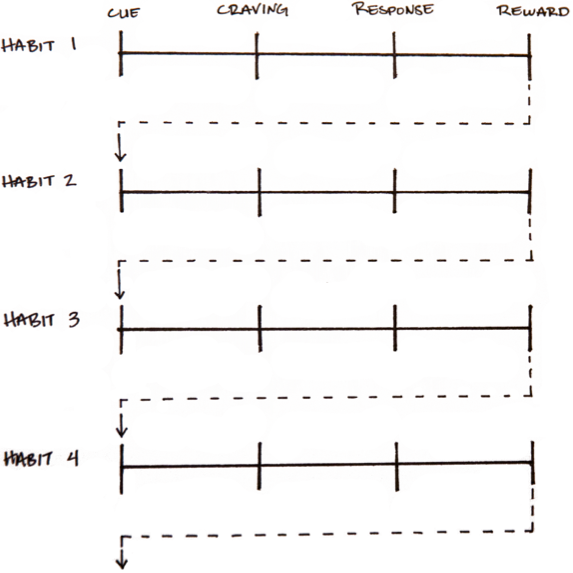
Habit stacking allows you to create rules that guide your behaviour. Select the right cue to kick things off. Consider when you are most likely to be successful. Your cue should also have the same frequency as your desired habit. This works best when the cue is specific and immediately actionable. Be specific and clear. The tighter a new habit is to a specific cue, the better the odds are that you'll notice when to act.
We often choose products not because of what they are, but because of where they are. Your habits change depending on where you are and the cues in front of you. Despite our unique personalities, certain behaviours tend to arise again and again under certain environmental conditions. The most common form of change is not internal, but external: we're changed by the world around us. Behaviour is a function of the Person in their Environment.
Many of the actions we take each day are shaped by the most obvious option. Visual cues are the greatest catalyst of our behaviour. A small change in what you see can lead to a big shift in what you do. When cues are subtle or hidden, they're easy to ignore. Make the cue a big part of your environment. Make the best choice the obvious one. You don't have to be the victim of your environment. You can be the architect of it.
Our behaviour is not defined by the objects in the environment but by our relationship to them. Stop thinking about your environment as filled with objects. Start thinking about it as filled with relationships. Go to a new place and create a new routine there.
It's easier to associate a new habit with a new context than to build a new habit in the face of competing cues. When you can't manage to get to an entirely new environment, redefine or rearrange your current one. Avoid mixing the context of one habit with another. If you want behaviours that are stable and predictable, you need an environment that is stable and predictable.
When context changes, so can the habit. Discipline people are better at structuring their lives in ways that doesn't require self-control. They spend less time in tempting situations. People with the best self-control are typically the ones who have to use it the least.
Once a habit is encoded, the urge to act follows when the environmental cue reappear. Bad habits are autocatalytic: the process feeds itself. Someone can't consistently stick to positive habits in a negative environment.
Eliminate a bad habit by reducing exposure to the cue that causes it. Rather than make it obvious, you can make it invisible. Remove a single cue and the entire habit fades away. Make the cues of good habits obvious and the cues of bad habits invisible.
The 2nd Law Make It Attractive
We have the brains of our ancestors but temptations they never had to face. Habits are a dopamine-driven feedback loop. Dopamine is released not only when you experience pleasure, but also when you anticipate it.
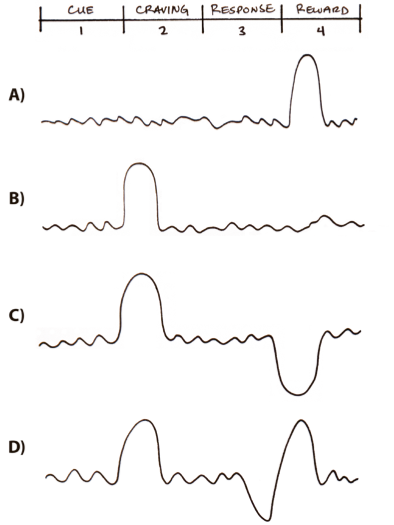
Your brain has more neural circuitry allocated for wanting rewards than for liking them. Desire drives behaviour, it leads to a response. By making habits attractive, the expectation of a rewarding experience motivates us to act.
Temptation bundling works by linking an action you want to do with an action you need to do. You're more likely to find a behaviour attractive if you get to do one of your favourite things at the same time. More probable behaviours reinforce less probable behaviours. Doing what you need, means getting to do what you want.
The habit stacking + temptation bundling formula is:
- After I [CURRENT HABIT], I will [HABIT I NEED].
- After [HABIT I NEED], I will [HABIT I WANT].
A genius is not born, but is educated and trained. Whatever habits are normal in your culture are among the most attractive behaviours. Humans are herd animals. We don't choose our earliest habits, we imitate them. Behaviours are attractive when they help us fit in. We imitate the habits of three groups in particular:
- The close.
- The many.
- The powerful.
Our friends and family provide an invisible peer pressure that pulls us in their direction. Culture sets your expectation for what is "normal". Join a culture where 1) your desired behaviour is the normal behaviour and 2) you already have something in common with the group. Nothing sustains motivation better than belonging to the tribe. It's friendship and community that embed a new identity and help behaviours last over the long term.
When we're unsure how to act, we look to the group to guide our behaviour. It's a smart strategy. There's evidence in numbers. But there can be a downside. When changing your habits means challenging the tribe, change is unattractive. When changing your habits means fitting in with the tribe, change is attractive.
Humans everywhere pursue power, prestige, and status. This tendency can seem vain, but overall, it's a smart move. We're drawn to behaviours that earn us respect, approval, admiration, and status. Once we fit in, we start looking for ways to stand out. We copy the behaviour of successful people because we desire it ourselves. We're motivated to avoid behaviours that would lower our status.
A craving is just a specific manifestation of a deeper underlying motive. Your habits are modern-day solutions to ancient desires. Your current habits aren't necessarily the best way to solve your problems. You see a cue, categorize it based on past experience, and determine the appropriate response. Life feels reactive, but it's actually predictive.
Behaviour is heavily dependent on how we interpret what happens to us, not necessarily the objective reality of the events themselves. The predictions lead to feelings, which is how we typically describe a craving, feeling, desire, or urge. But it's only when you predict that you would be better off in a different state that you take action.
The gap between your current state and your desired state provides a reason to act. Desire is the difference between where you are and where you want to be. When emotions and feelings are impaired, we lose the ability to make decisions. The specific cravings you feel and the habits you perform are an attempt to address your fundamental underlying motives.
Make hard habits more attractive by learning to associate them with a positive experience. Transition from seeing these behaviours as burdens and turn them into opportunities. Reframe habits to highlight their benefits rather than their drawbacks is a fast way to make a habit more attractive. These little mind-set shifts change the feelings associated with a particular habit or situation. The key to finding and fixing the causes of your bad habits is to reframe the associations you have about them.
The 3rd Law Make It Easy
It's easy to get bogged down trying to find the optimal plan for change. We're so focused on figuring out the best approach that we never get around to taking action. This is the difference between motion and action. With motion, you're planning, strategizing, and learning. Action, is behaviour that delivers an outcome.
Most of us are experts at avoiding criticism, we want to delay failure. When preparation becomes procrastination, you need to change something. You don't want to merely be planning. You want to be practicing. You need to get your reps in.
Neurons that fire together wire together. Repetition is a form of change. Putting in your reps is one of the most critical steps you can take to encoding a new habit. Automaticity is the ability to perform a behaviour without thinking about each step, which occurs when the non conscious mind takes over.
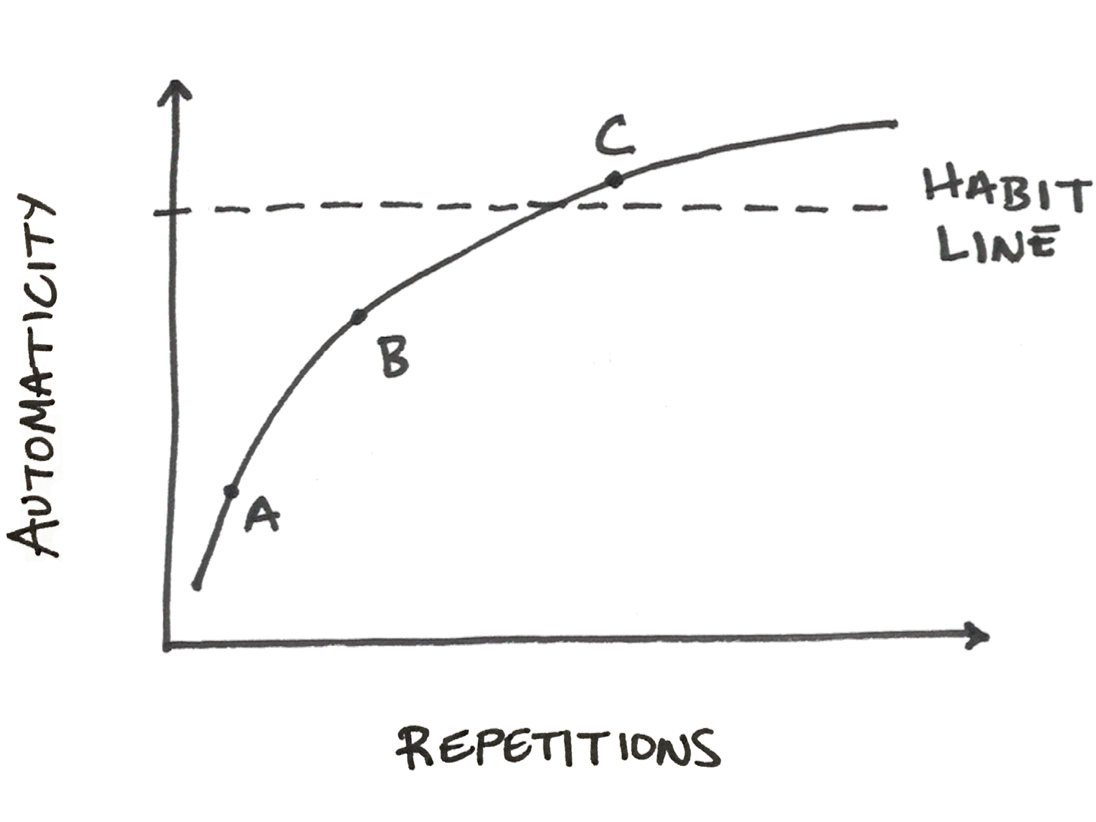
Learning curves, reveal that habits form based on frequency, not time. Ask , "How many does it take to form a new habit?" What matters is the rate at which you perform the behaviour. To build a habit, you need to practice it.
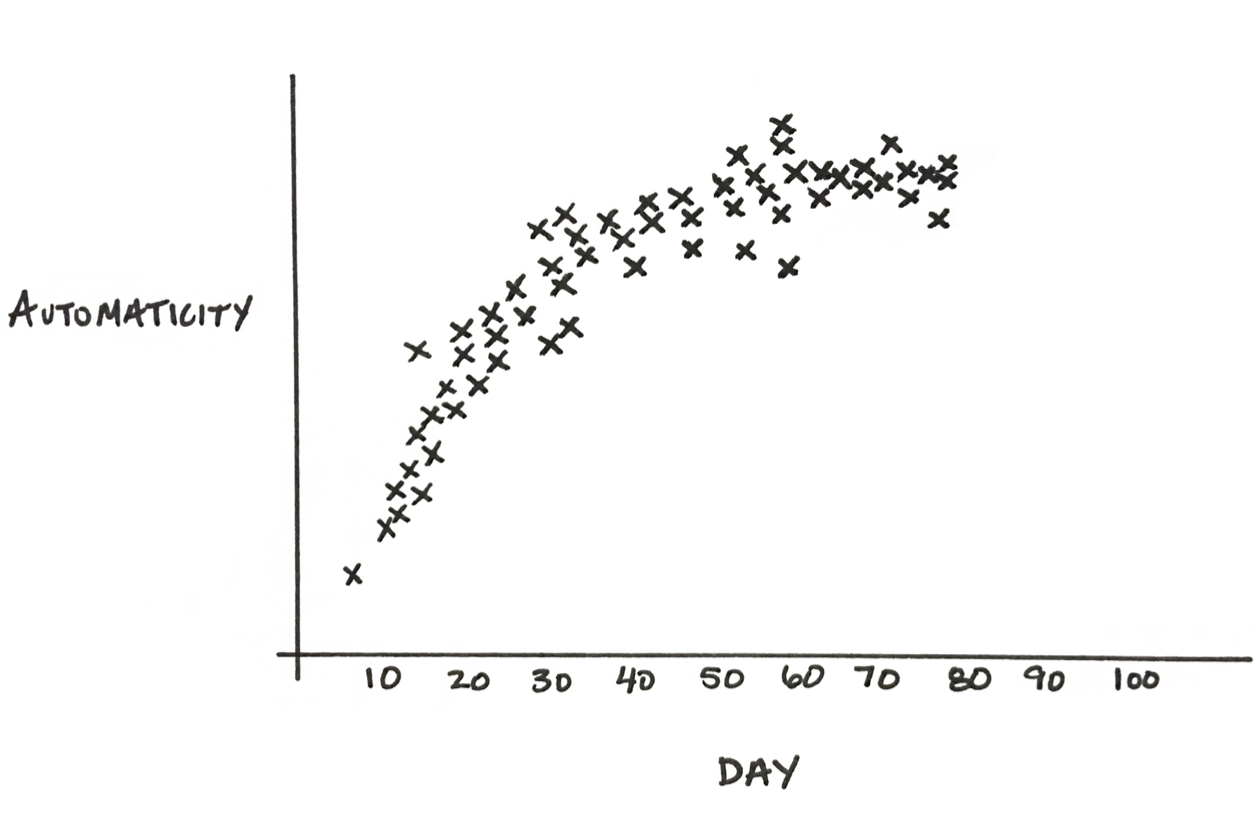
Our real motivation is to do what's convenient. The more energy that's required, the less likely an action is to occur. Every habit is an obstacle to getting what you really want. You don't want the habit itself, you want the outcome it delivers. Make good habits more convenient and you'll be more likely to follow through on them. Make it as easy as possible in the moment to do things that payoff in the long run.
Rather than trying to overcome friction, reduce it. Business is a never-ending quest to deliver the same result in an easier fashion. Create an environment where doing the right thing is as easy as possible. Much of the battle of building better habits comes down to finding ways to reduce the friction associated with good habits and increase the friction associated with bad ones.
When you organize a space for its intended purpose, you're priming it to make the next action easy. You can invert this principle and prime an environment to make bad behaviours difficult. The greater the friction, the less likely the habit. It's remarkable how little friction is required to prevent unwanted behaviour.
It's estimated that 40% to 50% of our daily actions are done out of habit. Decisive moments are moments that deliver an outsized impact. We're limited by where our habits lead us. Those little choices stack up, each one sets the trajectory for how you spend the next chunk of time. Habits are the entry point, not the end point.
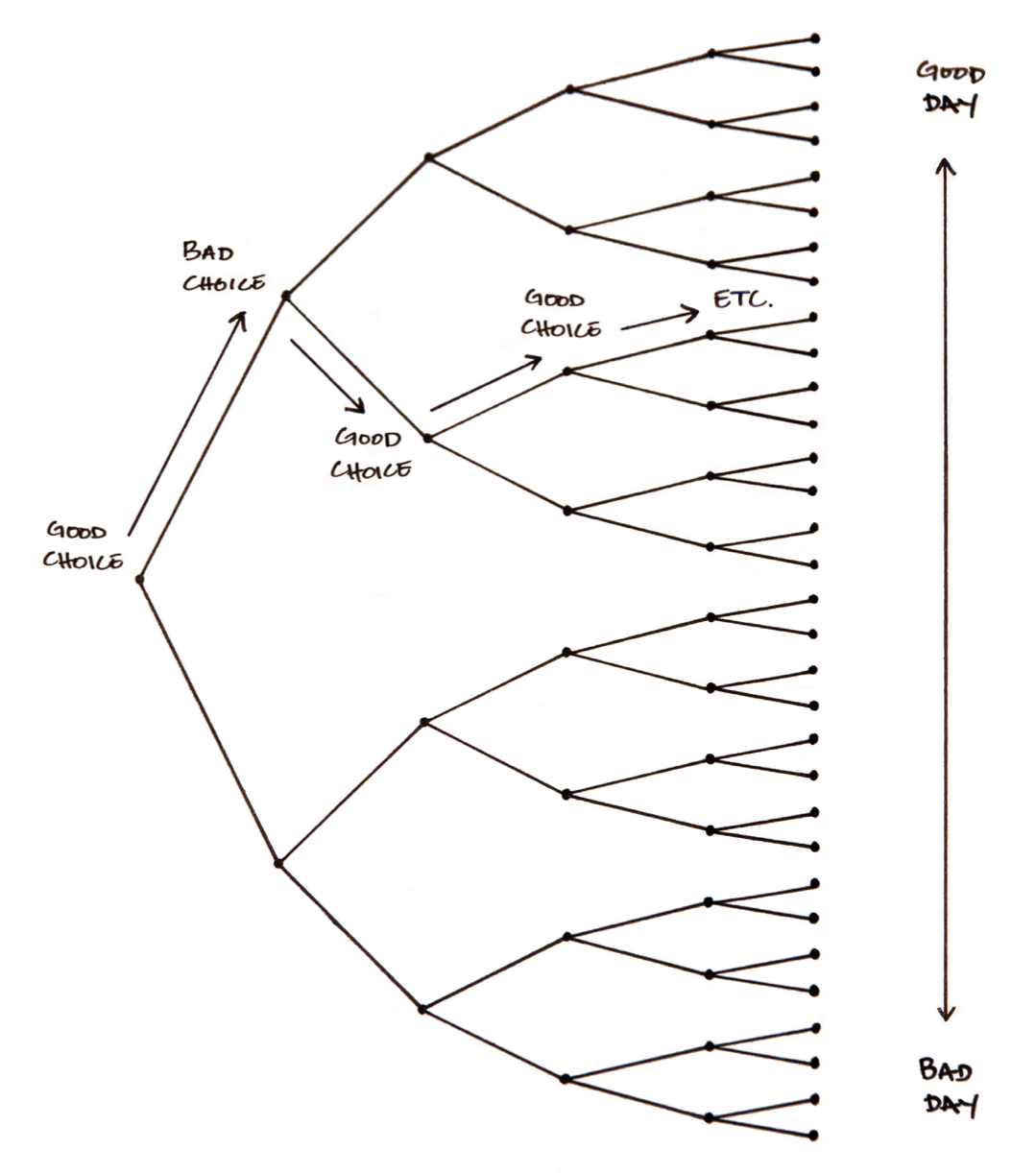
A new habit shouldn't feel like a challenge, it should naturally lead you down a more productive path. Master the habit of showing up. A habit must be established before it can be improved. You have to standardize before you can optimize. Make it easy to start and the rest will follow. Strategies like this reinforce your identity. It's better to do less than you hoped for than nothing at all. Any larger life goal can be transformed into a two-minute behaviour.
Sometimes success is less about making good habits easy and more about making bad habits hard. The inversion of the 3rd Law is to make it difficult. Commitment devices are useful because they enable you to take advantage of good intentions before you can fall victim to temptation. Change the task so it requires more work to get out of the good habit than to get started on it.
The best way to break a bad habit is to make it impractical. Increase the friction until you don't have the option to act. When you automate as much as possible, you can spend your effort on the tasks machines cannot. Once bad habits become impossible, you have the motivation to work on more meaningful tasks.
The 4th Law Make It Satisfying
Feelings of pleasure are signals that tell the brain: "This feels good. Do this again." If an experience is not satisfying, we have little reason to repeat it. What is rewarded is repeated. What is punished is avoided. The first three laws increase the odds that a behaviour will be performed this time. The fourth law increases the odds that a behaviour will be repeated next time.
You value the present more than the future. Consequences of bad habits are delayed while rewards are immediate. Every habit produces multiple outcomes. With bad habits, the immediate outcome feels good, but the ultimate outcome feels bad. With good habits, it's the reverse. The costs of good habits are in the present. The costs of bad habits are in the future. We all want better lives for our future selves, however, instant gratification usually wins. What's immediately rewarded is repeated. What's immediately punished is avoided. The road less traveled is the road of delayed gratification.
Make a habit feel successful, even in a small way. In the beginning, you need a reason to stay on track. This is why immediate rewards are essential. They keep you excited while the delayed rewards accumulate. The ending of any experience is vital because we tend to remember it more than other phases. Reinforcement ties your habit to an immediate reward, making it satisfying when you finish.
Make avoidance visible. Select short-term rewards that reinforce your identity rather than ones that conflict with it. Do it because it's who you are and it feels good to be you. Incentives can start a habit, identity sustains it. Immediate reinforcement helps maintain motivation in the short term while you're waiting for the long-term rewards. Change is easy when it's enjoyable.
Habit tracking makes a behaviour obvious, attractive, and satisfying. Recording your last action creates a trigger that initiates your next one. People who track their progress are all more likely to improve than those who don't. Tracking a behaviour sparks the urge to change it. Measurement offers one way to overcome our blindness to our own behaviour.
The most effective form of motivation is progress. Each small win feeds your desire. Tracking can become its own form of reward, you're focused on the process rather than the result. Habit tracking: 1) creates a visual cue that reminds you to act, 2) is inherently motivating because you see the progress you're making and don't want to lose it, 3) feels satisfying when you record another successful instance of your habit.
Measurement should be automated. Manual tracking should be limited to your most important habits. Record each measurement immediately after it occurs.
After I [CURRENT HABIT], I will [TRACK MY HABIT].
Perfect isn't possible, so never miss twice. The first mistake is never the one that ruins you. It's the spiral of repeated mistakes that follows. The problem isn't slipping up; it's thinking that if you can't do it perfectly, you shouldn't do it at all. Never interrupt compounding unnecessarily. Sluggish days and bad workouts maintain the compound gains you accrued from previous good days. Don't put up a zero. Don't let losses eat into your compounding. Reaffirm your identity.
We focus on working long hours instead of getting meaningful work done. We optimize for what we measure. When we choose the wrong measurement, we get the wrong behaviour. When a measure becomes a target, it ceases to be a good measure.
We're more likely to avoid an experience when the ending is painful. When consequences are severe, we learn quickly. When actions incur an immediate consequence, behaviour changes. The strength of the punishment must match the relative strength of the behaviours it's trying to correct. Behaviour only shifts if the punishment is painful enough and reliably enforced. The more local, tangible, concrete, and immediate the consequence, the more likely it is to influence individual behaviour.
A habit contract is an agreement where you state your commitment to a particular habit and the punishment that will occur if you don't follow through. To make bad habits unsatisfying, make them painful in the moment. We care about the opinions of those around us because it helps if others like us. Getting an accountability partner or signing a habit contract can work well.
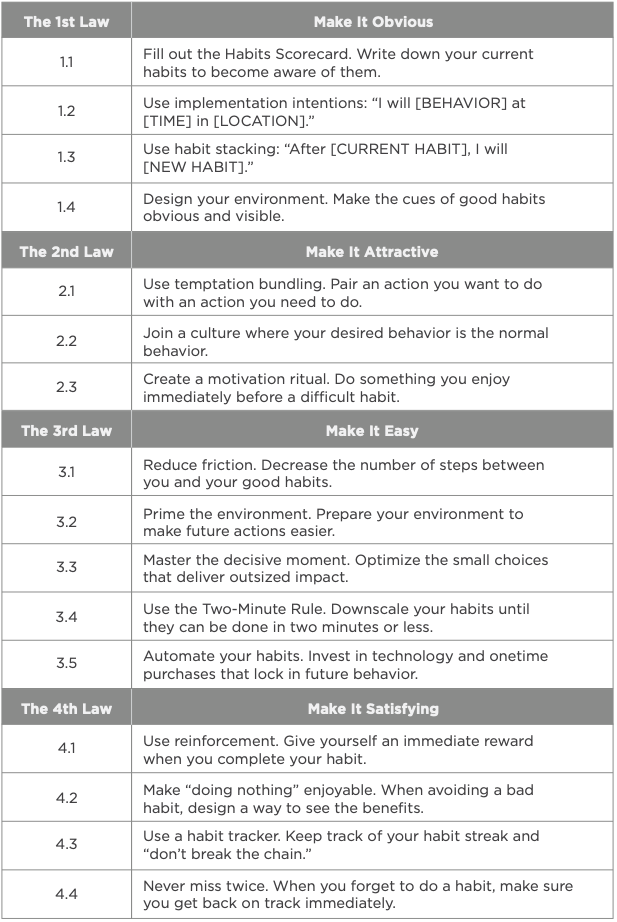
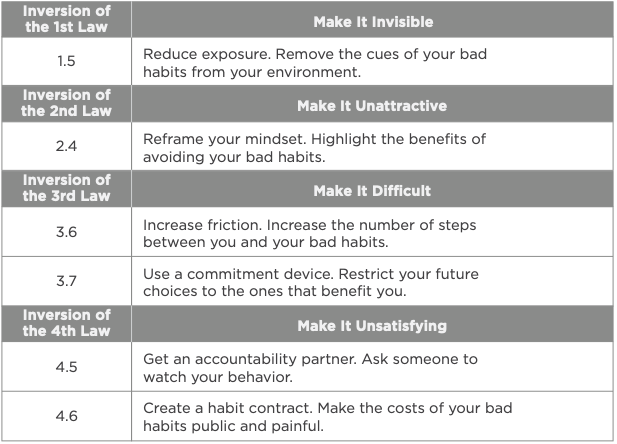
Advanced Tactics
Maximizing your odds of success by choosing the right field of competition. Habits are easier to perform, and more satisfying, when they align with your natural inclinations. Play a game where the odds are in your favour. People are born with different abilities.
When our environment changes, so do the qualities that determine success. Competence is highly dependent on context. Genes do not determine your destiny. They determine your areas of opportunity. Genes can predispose, but they don't predetermine. Direct your effort towards areas that both excite you and match your natural skills.
Your genes are operating beneath the surface of every habit. Build habits that work for your personality. Choose the habit that suits you, not the one that is popular. Habits need to be enjoyable.
You can enjoy almost anything, but you're more likely to enjoy what comes easily to you. Pick the right habit and progress is easy. Pick the wrong habit and life is a struggle. Exploit what works, explore when it doesn't. Work on the strategy that delivers the best results about 80% of the time and keep exploring with the remaining 20%. Ask yourself:
- What feels like fun to me, but work to others?
- What makes me lose track of time?
- Where do I get greater returns than the average person?
- What comes naturally to me?
When you can't win by being better, win by being different. Great players create a game that favours their strengths and avoids their weaknesses. Specialization is a powerful way to overcome bad genetics. The more you master a skill, the harder it becomes for others to compete with you. If you can find a more favourable environment, you can transform the situation to one where the odds are in your favour.
Our genes do not eliminate the need for hard work. They clarify it. We know which opportunities to look for and which challenges to avoid. Focus on whether you're fulfilling your own potential than comparing yourself to someone else. People get caught up in the fact that they have limits that they rarely exert the effort required to get close to them. Until you work as hard as those you admire, don't explain away their success as luck.
The human brain loves a challenge, but only if it's within an optimal zone of difficulty. Humans experience peak motivation when working on tasks that are right on the edge of their current abilities. When starting a new habit, keep it simple so you can stick with it when conditions aren't perfect. Once a habit has been established, continue to advance in small ways.
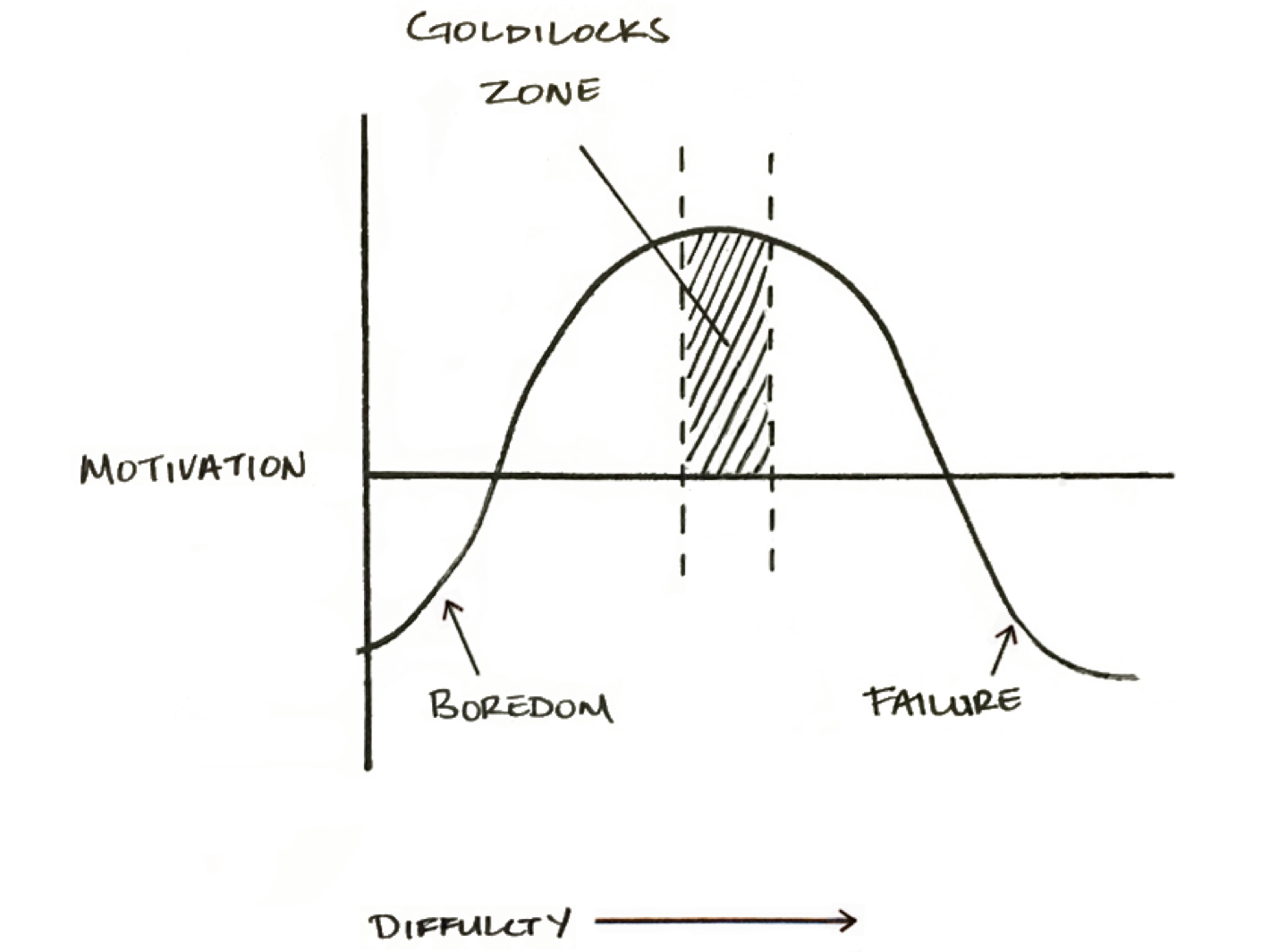
You need to regularly search for challenges that push you to your edge while making enough progress to stay motivated. Boredom is perhaps the greatest villain on the quest for self-improvement. It comes down to who can handle the boredom of training every day.
Really successful people feel the same lack of motivation as everyone else. The difference is that they still find a way to show up. Mastery requires patience. The greatest threat to success is not failure but boredom. As soon as we experience the slightest dip in motivation, we begin seeking a new strategy, even if the old one was still working.
Variable rewards are a powerful way to amplify the cravings we experience because they reduce boredom. The sweet spot of desire occurs at a 50/50 split between success and failure. If you're interested in a habit, working on challenges of just manageable difficulty can keep things interesting. Fall in love with boredom.
Stepping up when it's not ideal, differentiates a professional from an amateur. Professionals work towards it with purpose; amateurs get pulled off course. They may not always enjoy it, but they put the reps in. You'll never regret showing up and working on something that's important to you.
Habits create the foundation for mastery. When you know the simple movements so well that you perform them without thinking, you can pay attention to more advanced details. The benefits of habits come at a cost. When you can do it "good enough" on autopilot, you stop thinking about doing it better. Research shows that once a skill has been mastered, there's usually a slight decline in performance. Combine automatic habits and deliberate practice.
Habits + Deliberate Practice = Mastery
After a habit has been mastered, begin building the next habit. Mastery is an endless cycle of narrowing your focus to a tiny element of success, repeating it until you have internalized the skill, and using this new habit as the foundation to advance to the next stage of your development.
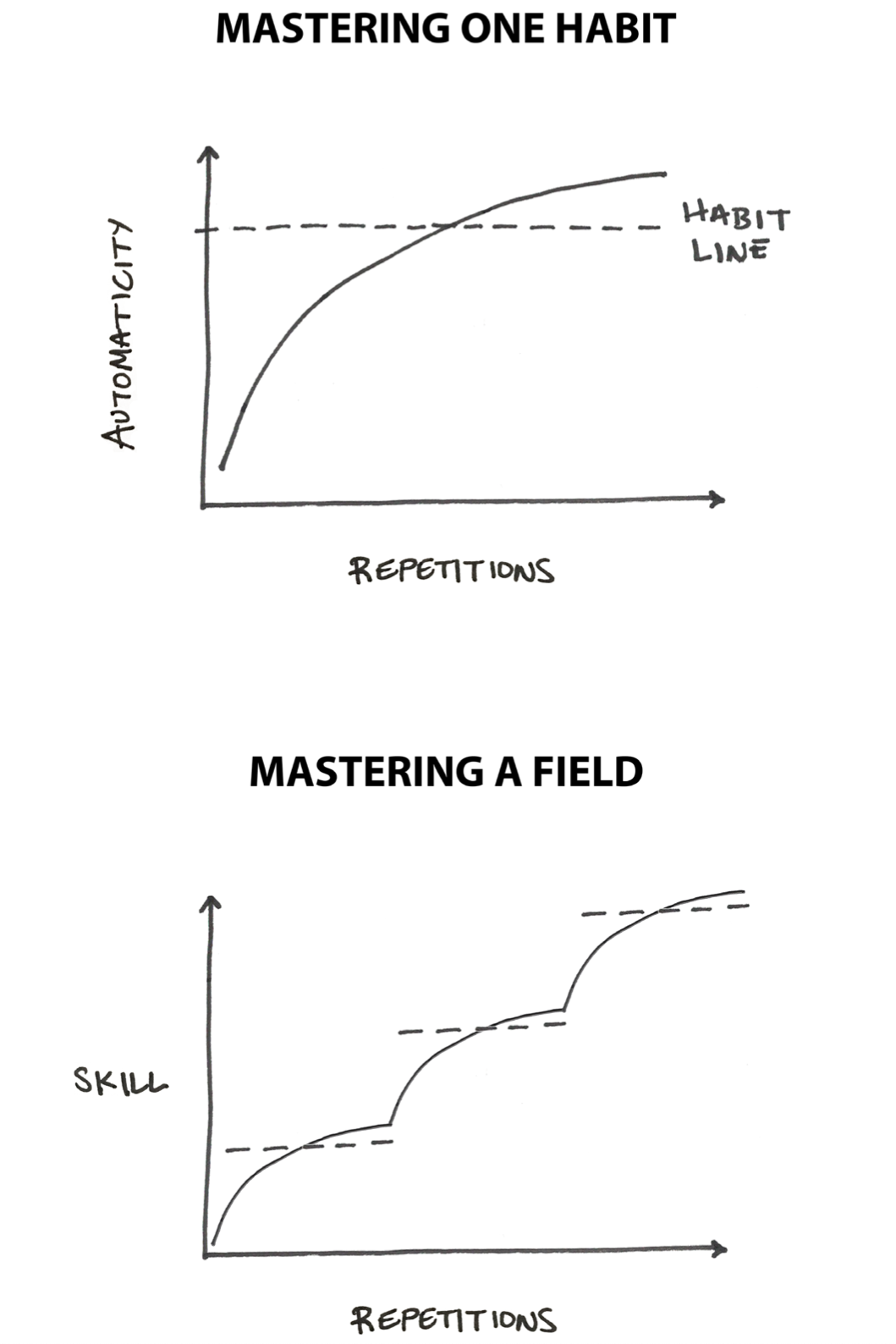
It's precisely at the moment when you begin to feel like you have mastered a skill, that you must avoid slipping into the trap of complacency. Establish a system for reflection and review.
Sustain effort. Learn how to do things right, then do them the same way every time. Improvement is about fine-tuning habits. Reflect on 1) your progress (or lack thereof), and 2) your identity and how you can work toward being the type of person you wish to become. View the entire mountain range, don't obsess over each peak and valley.
When working against you, your identity creates a "pride" that encourages you to deny your weak spots and prevents you from growing. This is a great downside of building habits. The more sacred an idea is to us, the stronger we'll defend it. The more we cling to an identity, the harder it is to grow beyond it.
The more you let a single belief define you, the less capable you are of adapting when life challenges you. When chosen effectively, an identity can be flexible rather than brittle. Like water flowing around an obstacle, your identity works with the changing circumstances rather than against them. Everything is impermanent.
At some point, you'll have to admit that your life was transformed by one small change. The weight of the system is working for you rather than against you. Success is not a goal to reach or a finish line to cross. It's a system to improve, an endless process to refine.
A habit will be hard to remember and you'll need to make it obvious. You won't feel like starting and you'll need to make it attractive. You may find that a habit is too difficult and you'll need to make it easy. You won't feel like sticking with it and you'll need to make it satisfying.
This is a continuous process, There is no finish line, There is no permanent solution. The secret to getting results that last is to never stop improving. Small habits don't add up. They compound.
That's the power of atomic habits. Tiny changes. Remarkable results.
🧠 Final Thoughts
At the time of this article, Atomic Habits has sold more than 15 million copies, and sits #1 on Amazon Charts as both Most Read and Most Sold nonfiction book of the week. Lists that it has spent the last 275 weeks on. After reading the book, and writing this detailed summary, I understand why.
Our habits, as small as they may seem in the moment, have incredible power. They're not only what we do each and every day, they show us what matters most to us, by reflecting our deepest values. Close up, a single habit reflects a single action or behaviour. Full picture, our habits reflect what's important to us and who we wish to become.
We can better understand how our habits compound over-time, either for or against us. Which leads us to be able to make better decisions based on what's important to us. No matter who you are, the positive change that you're looking for might only be a single habit away. Instead of coasting on autopilot and hoping for the best, we can take action to create the best.
❤️ Liked This? Check These Out
Feel Good Productivity by Ali Abdaal, how to do more of what matters to you
Start With Why by Simon Sinek, how great leaders inspire everyone to take action
Same As Ever by Morgan Housel, a guide to what never changes
All ideas, quotes, and illustrations are borrowed or based on Atomic Habits by James Clear. To learn more, visit www.jamesclear.com.


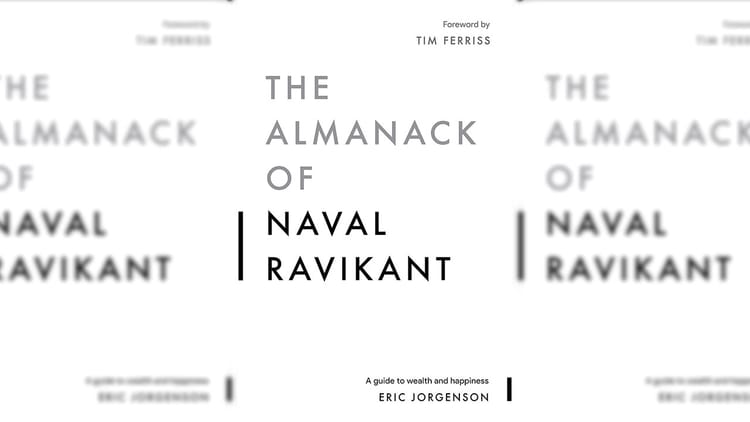



Member discussion